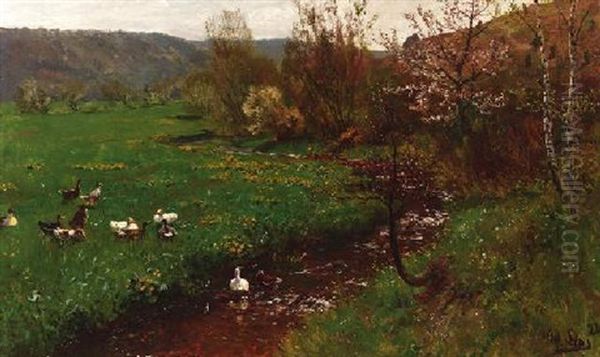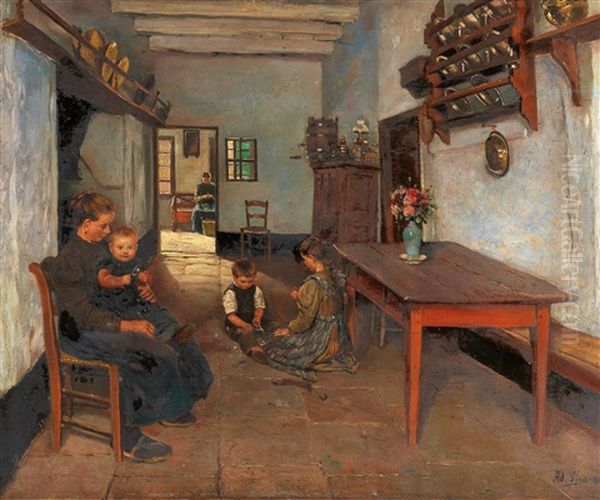Adolf Lins stands as a notable figure in late 19th and early 20th-century German art, celebrated for his affectionate and detailed portrayals of rural life, particularly scenes involving children and domestic animals. Born in 1856 and passing away in 1927, Lins carved a niche for himself within the German art world, primarily associated with the Düsseldorf region and the influential Willingshausen artists' colony. His work, characterized by naturalism and a keen eye for atmospheric detail, continues to resonate with audiences appreciative of idyllic landscapes and the simple charms of the countryside.
Early Life and Artistic Formation
Adolf Lins embarked on his artistic journey with formal training at the Academy of Fine Arts in Kassel. This foundational education provided him with the technical skills necessary to pursue a career in painting. A significant moment in his early development occurred in 1874 when, reportedly following the advice of one of his instructors, he made his first study trip to Willingshausen. This village, located in the picturesque Schwalm region of Hesse, was already gaining recognition as a gathering place for artists drawn to its unspoiled landscapes and traditional culture.
Willingshausen was, in fact, developing into one of Germany's earliest and most enduring artists' colonies. Artists were attracted by the opportunity to paint en plein air (outdoors), directly capturing the effects of natural light and atmosphere, a practice gaining prominence across Europe during this period. This initial visit likely exposed Lins to the unique visual motifs and the communal artistic spirit that would significantly influence his later work and career choices. The experience in the Schwalm region cemented his interest in rural themes and direct observation from nature.
The Move to Düsseldorf and Artistic Circle
The connections Lins forged during his formative years proved instrumental in shaping his career path. By 1877, drawn by friendships with artists based there, Lins decided to relocate to Düsseldorf. This city was a major art center in Germany, home to the renowned Düsseldorf School of Painting, which, although perhaps past its mid-century peak, still fostered a vibrant artistic community. Lins quickly integrated into this environment, establishing important professional and personal relationships.

Among his notable Düsseldorf contemporaries and friends were painters like Heinrich Sondermann, Hugo Mühlig, and Hans Richard von Volkmann. These interactions provided Lins with artistic camaraderie, opportunities for intellectual exchange, and likely mutual inspiration. The Düsseldorf art scene was diverse, encompassing various styles from late Romanticism to emerging Realism and Naturalism. Lins found his place within this milieu, further developing his signature style focused on landscape and genre painting.
His practical life in Düsseldorf also took shape during this time. He reportedly found lodging and perhaps studio space with a local craftsman, G. Paffrath, who worked as a carpenter and shipper. Furthermore, Lins is known to have collaborated or worked alongside fellow artist Ferdinand Brütt, another figure in the Düsseldorf art world. These connections highlight his active participation in the city's artistic and social fabric. His involvement likely extended to local artist associations, such as the esteemed Künstlerverein Malkasten, a hub for Düsseldorf artists.
Artistic Style: Naturalism and the Idyllic Countryside
Adolf Lins's artistic style is firmly rooted in Naturalism and Realism, tempered with a gentle, often idyllic sensibility. He possessed a remarkable ability to observe and render the nuances of the natural world, paying close attention to detail, texture, and the play of light and shadow. His canvases often exude a fresh, vibrant atmosphere, capturing specific moments in time within the rural landscape. Color and contrast are employed effectively to create depth and visual interest, drawing the viewer into the scene.
His subject matter remained consistent throughout much of his career, focusing predominantly on the German countryside. He showed a particular fondness for scenes set near water – village streams, ponds, and riverbanks – often populated by his most famous subjects: ducks and geese. His skill in depicting these birds was so recognized that he earned affectionate nicknames such as "Gänse-Lins" (Geese-Lins) or "Enten-Lins" (Duck-Lins). These creatures were rarely mere background elements; Lins captured their movements and character with lively accuracy.
Beyond the animal subjects, children frequently feature in his paintings, often shown interacting naturally with their rural environment – tending to geese, playing by a stream, or simply observing the world around them. These depictions avoid overt sentimentality, instead focusing on the quiet authenticity of everyday moments. Lins's landscapes themselves, whether depicting the Schwalm region or other areas like the broader Hessian countryside, emphasize the tranquil beauty and specific character of the German rural environment. His commitment to direct observation, likely reinforced by his experiences in Willingshausen, lends his work an air of authenticity and immediacy.
Representative Works and Signature Themes

Several paintings stand out as representative of Adolf Lins's oeuvre, showcasing his characteristic style and thematic concerns. Frühling in der Schwalm (Spring in the Schwalm) exemplifies his connection to the Willingshausen region and his ability to capture seasonal beauty. This oil painting, though modest in size (24 x 36 cm), likely depicts the burgeoning life and light associated with springtime in the Hessian countryside, possibly featuring the local traditional costumes or architecture for which the Schwalm is known.
Enten am Bachlauf (Ducks by the Stream) is another quintessential Lins work. Larger in scale (75 x 95 cm), this oil painting would prominently feature his celebrated waterfowl subjects within a naturalistic streamside setting. Such works allowed Lins to demonstrate his skill in rendering water, foliage, and the dynamic energy of the birds themselves. The popularity of these duck and geese scenes contributed significantly to his reputation and market appeal during his lifetime.
Bauer mit Riehaviehm an der Waldrand (Farmer with Poultry/Geese at the Forest Edge), an oil painting measuring 71 x 53 cm, combines human figures with animal subjects within a landscape context. It likely portrays a scene of rural labor or daily life, set against the backdrop of a forest margin, allowing for interesting plays of light and shadow. The term "Riehaviehm" likely refers to poultry, probably geese given Lins's preference. This work underscores his focus on the harmonious relationship between the inhabitants and the landscape.
Other titles like In The Parlour suggest occasional forays into interior genre scenes, perhaps depicting domestic life, while A Mother Delousing Her Child’s Hair points to an interest in intimate, everyday human interactions, rendered with realistic detail. A work titled Weite hessische Landschaft (Broad Hessian Landscape) highlights his capacity for capturing more expansive landscape views, showcasing the specific topography and atmosphere of the Hessian region. Across these works, common threads include careful execution, signed canvases, and a focus on capturing the essence of rural German life and nature.
The Willingshausen Artists' Colony Connection
Adolf Lins's connection to the Willingshausen artists' colony remained significant throughout his career. While he settled in Düsseldorf, his initial study trip in 1874 marked the beginning of a lasting affinity for the Schwalm region and its artistic community. Willingshausen holds the distinction of being one of Germany's oldest formal artists' colonies, attracting painters seeking authentic rural subjects and the camaraderie of fellow artists working directly from nature.

The colony's origins trace back to the mid-19th century, with figures like Gerhardt Wilhelm von Reutern and the influential genre painter Ludwig Knaus being early proponents. Over the decades, numerous artists spent time working in Willingshausen, contributing to its reputation. Besides Lins's friends like Hugo Mühlig and Hans Richard von Volkmann, other notable artists associated with the colony at various times included Carl Bantzer, Wilhelm Claudius, Otto Ubbelohde (famous for his illustrations of Grimm's Fairy Tales), and Paul Baum, who later embraced Neo-Impressionism.
Lins's participation, even if intermittent after his move to Düsseldorf, placed him within this important tradition of German landscape and genre painting. The emphasis on plein air painting and the focus on the specific cultural landscape of the Schwalm – its traditional costumes (Schwälmer Tracht), architecture, and agricultural rhythms – are reflected in the works of many Willingshausen artists, including Lins. His paintings contribute to the visual documentation and romantic interpretation of this unique region during a period of gradual societal change.
Context within German Art of the Era
To fully appreciate Adolf Lins's position, it's helpful to consider the broader context of German art during the late 19th and early 20th centuries. This was a period of transition and stylistic diversity. While Lins operated primarily within a Naturalist/Realist framework, German art also saw the influence of French Impressionism, the development of German Impressionism (led by figures like Max Liebermann, Lovis Corinth, and Max Slevogt), and the continuation of strong academic traditions.
Painters like Wilhelm Leibl and his circle championed a form of meticulous Realism, often focusing on peasant life, which shares some thematic ground with Lins, though Leibl's approach was often more stark. Fritz von Uhde introduced Impressionistic light and contemporary social themes into religious and everyday scenes. Meanwhile, artists like Franz von Lenbach excelled in portraiture within a more traditional style, and figures such as Arnold Böcklin pursued Symbolism, exploring mythological and allegorical themes far removed from Lins's grounded naturalism.
The Düsseldorf School itself, while influential, was evolving. Its earlier emphasis on historical and romantic landscapes was giving way to more naturalistic genre scenes and landscapes, the very type of art Lins excelled at. Artists like Andreas Achenbach and Oswald Achenbach represented the earlier landscape prowess, while Lins and his contemporaries like Hugo Mühlig represented a later phase focusing on more intimate, atmospheric depictions of nature and rural life. Lins's work, therefore, sits comfortably within a significant stream of German art that valued observation, craftsmanship, and the depiction of the national landscape and its people.
Legacy and Art Historical Standing
Adolf Lins occupies a respected, if not revolutionary, place in German art history. He was not an avant-garde innovator pushing the boundaries of modernism, but rather a master craftsman working within established traditions of landscape and genre painting. His contribution lies in the consistent quality, charm, and atmospheric sensitivity of his work. He captured a specific vision of German rural life – peaceful, orderly, and intimately connected with nature – that held great appeal for audiences of his time and continues to attract collectors today.
His reputation as "Gänse-Lins" underscores his particular success in depicting waterfowl, a niche that brought him considerable recognition. His paintings were exhibited during his lifetime and found their way into private collections. Today, his works regularly appear at auction houses, particularly in Germany, demonstrating a continued market interest. While prices vary, the consistent demand reflects an appreciation for his technical skill and the enduring appeal of his subject matter.
While perhaps not prominently featured in every major international museum's narrative of modern art, his work is represented in German collections, particularly those focusing on the Düsseldorf School, Hessian art, or 19th-century German painting. His association with the Willingshausen colony ensures his place in the history of German artists' colonies and the tradition of plein air painting. He is remembered as a skilled and dedicated chronicler of the German countryside, whose paintings offer a window onto the landscapes and daily rhythms of a bygone era.
Conclusion: Chronicler of Rural Tranquility
Adolf Lins remains a significant figure for his dedicated and skillful portrayal of German rural life in the late 19th and early 20th centuries. His education in Kassel, his integration into the Düsseldorf art scene, and his enduring connection to the Willingshausen artists' colony all shaped his artistic output. Through his naturalistic style, keen observation, and focus on atmospheric detail, he created charming and evocative scenes of landscapes, children, and especially his signature ducks and geese. While working within the bounds of Realism and Naturalism, Lins imbued his subjects with a warmth and liveliness that secured his popularity during his lifetime and ensures his continued appreciation. His paintings serve as valuable documents of regional German culture and landscape, celebrated for their technical proficiency and gentle, idyllic vision of nature.